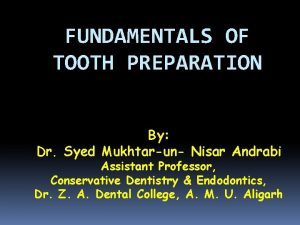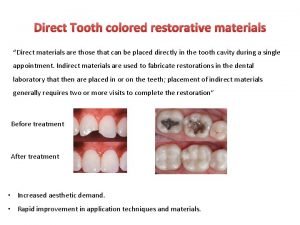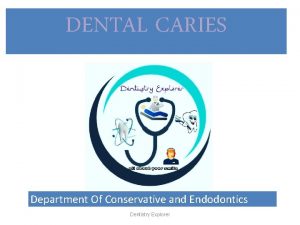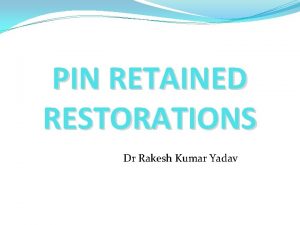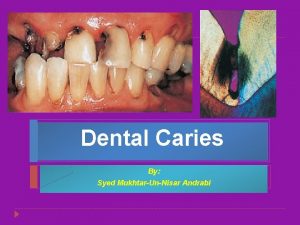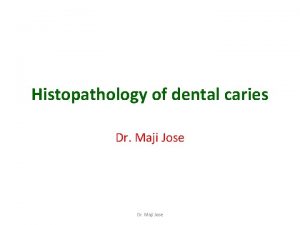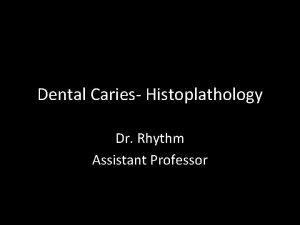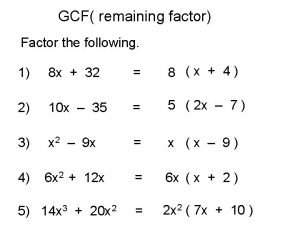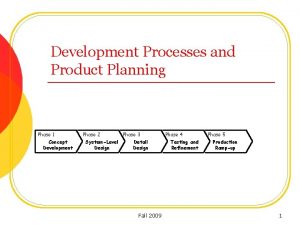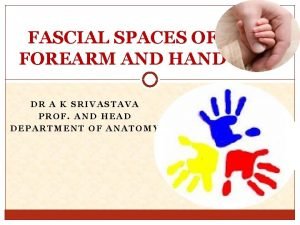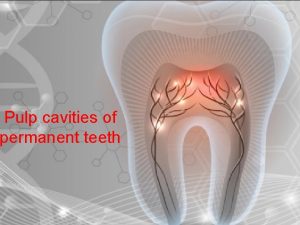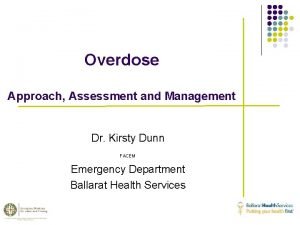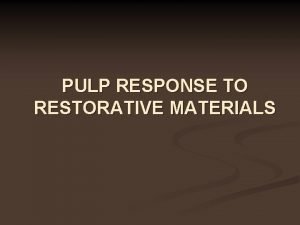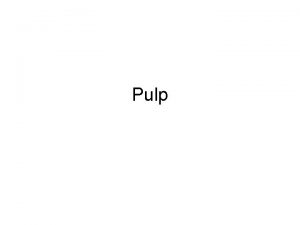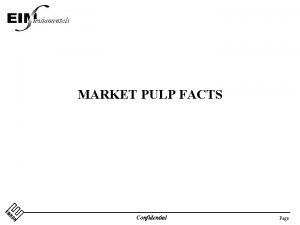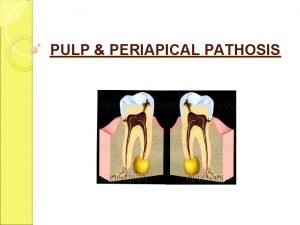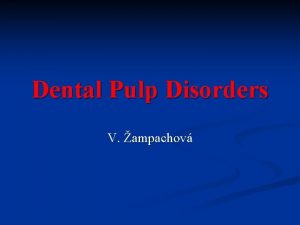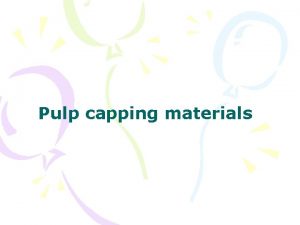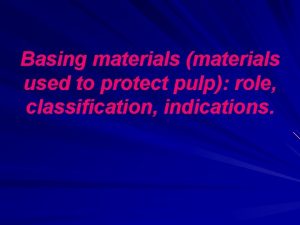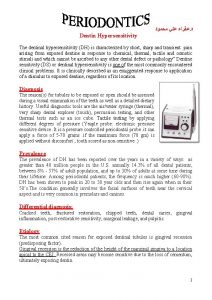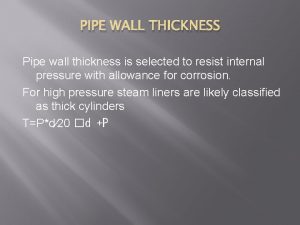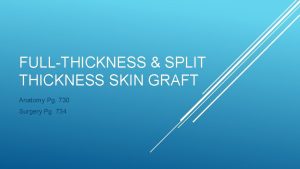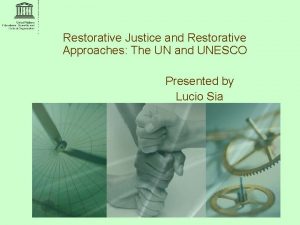PULP RESPONSE TO RESTORATIVE MATERIALS Remaining Dentinal Thickness































- Slides: 31

PULP RESPONSE TO RESTORATIVE MATERIALS

Remaining Dentinal Thickness SIGNIFICANCEn Amount of RDT underneath tooth preparation plays most important role in the incidence of a pulp response n In teeth , dentin is approx 3 mm thick n RDT of more than 2 mm – adequate.

n Dentin permeability increases with decreasing RDT n At RDT of 0. 75 mm effects of bacterial invasion is seen. At RDT of 0. 25 mm odontoblastic cell death is seen. n n RDT can be measured n Radiographs n Sonic probes – send Ultrasonic waves through dentin bridge and recover them.

Glass Ionomer Cement n PAA is a weak acid - high mol wt. - large mol size. Despite low p. H, GIC causes insignificant pulpal damage. n Luting consistency of GIC is more acidic. n

n Higher powder-liquid ratio has fewer adverse effects on pulp Inflammatory response of pulpal tissue towards GIC resolves within 30 days and there is no enhancement of reperative or secondary dentin formation. n RMGIC n

Zinc Oxide Eugenol n n Potential to diffuse through dentin May produce either beneficial or toxic effects Eugenol applied for prolonged periods causes pulpal irritation Greater the amount of free Eugenol, greater the chance of pulpal irritation…. .

n Therapeutic Properties Anodyne effect – due to eugenol’s ability to block or reduce nerve impulse activity n Anti-inflammatory activity – through the inhibition of prostaglandin synthesis n Antibacterial effects – due to inhibitory activity n

Zinc Phosphate Cement n Causes severe pulpal irritation n Pulp may be affected by Components of the material, n Heat liberated (2. 140 C) during setting & n Marginal leakage. n

n Toxicity is more pronounced when placed in deep cavity preparations so a intervening liner is required. n Thin mix has p. H of 1. 5 - 1. 6. Delay setting which prolongs irritating effects & heat generated n After 24 hrs ph 5. 5 never neutralization reached. n

Polycarboxylate cement n Well tolerated by pulp equivalent to Zn. OE n Less microleakage because of better chemical adhesion to tooth n Strong antibacterial properties.

Composites n n Acrylic monomer used in self curing resins is irritating to the pulp Polymerization Shrinkage – marginal leakage with recurrent caries and pulpal damage. Epoxy resins with benzoyl peroxide catalyst is more favorable Bonding agent reduces microbial invasion.

Dental Amalgam n “Safest filling material” n Of all permanent filling materials, amalgam is the least irritating to the pulp.

n Mild to moderate inflammatory response is seen n Mainly related to physical insertion of amalgam… n Alloys with high copper more pulpal response than conventional n Galvanic action produces corrosion

Gold Inlay Gold inlays are inherently irritating to the pulp. n Also n Thin mix of zinc phosphate used n Large amount of pressure in seating… n Marginal leakage – Poorly adapted margins - Excessive use of cement…. . n

Gold Foil Gold foil has excellent marginal sealing qualities n Gold foil irritates the pulp n Mechanical malleting n If the duration of application of malleting force is short, there is quick pulp recovery. n Inflammatory reaction in the pulp is due to pressure transmitted to the pulp cells through dentin n Avoided in young tooth…. n

Current thinking of the Cause of Pulpal Reaction to Restoration Microleakage Three possible routes of microleakage § With in or via the smear layer § Between the smear layer and the cement § Between the cement and the restorative material n n § § Rate of diffusion of substance depend on Concentration gradient of substance Surface area available for diffusion

PULP RESPONSE TO TOOTH PREPARATION

Tooth preparation n Tooth prep will result in rise of temp above 46°C - irreversible changes such as stasis & thrombosis in the pulpal blood vessels n Every sq. mm of dentin contains 30, 000 to 45, 000 dentinal tubules – irritate millions of odontoblasts

Depends on n Depth of the preparation n Speed of rotation n Nature of the cutting instrument n Coolant n Polishing of restoration

Depth of Cavity Preparation Most critical factor in determining degree of pulpal response – RDT n Minimal effects are transmitted to the pulp if RDT is 2 mm n As cavity preparation progresses towards pulp n No. of dentinal tubules increases n Increase in tubule diameter. n

n Cavity preparation close to DEJ causes only mild irritation Increased cavity depth Cutting of Odontoblastic tubules Increase in irritation Increase in rate of formation of Reparative

n The relationship between increased rate of reparative dentin formation & increased depth of cavity preparation -- RDT is at least half the original thickness. n Further cutting causes greater injury to odontoblasts n Rate of formation of reparative dentin decreases

Speed of Rotation Odontoblast injury varies in degree when dentin is cut n Greatest odontoblast damage – 50, 000 rpm n Least amount of damage – 1, 50, 000 – 2, 50, 000 rpm with coolants n Speeds between 3000 – 30000 rpm even with coolants are most deleterious to the pulp.

Nature of Cutting Instruments n Thermal damage is greater with steel burs than with carbide burs.

Coolants Dry cavity preparation causes greater trauma to the pulp than preparation under water spray. n Prolonged dehydration causes odontoblastic displacement and pulpal edema n Cannot be reversed by moistening the dentin after cavity preparation Agents n Air spray n Combination air and water n Water spray n Water applied through hollow bur n Water as a jet stream n

Air Spray Air blasts are damaging to pulp n Compressed air for 10 seconds – produces displacement of odontoblastic nuclei. n Recovery n health of pulp n extent and depth of preparation, n extent of damage and n no. of cells present n n Cavity should not be dried with air blasts, instead use cotton pellets

Water spray Temperature elevation is reduced n Rate of removal of debris increased n Control inflammation reaction in pulp n

Polishing of Restorations Polishing of restorations without taking precautions for dissipation of heat is dangerous to pulp. n Elevation of temperature because of friction n Heat generated can cause enamel to fracture n Polishing instruments should run intermittently at low speeds or in n

Prevention To preserve the integrity of Pulp tissue. Cutting procedures; use light, intermittent cutting, an efficient cooling system, high speed of rotation n Avoid desiccating the dentin n Do not apply irritating chemicals to freshly cut dentin n Choose restorative materials carefully, considering physical and biological property of the material n

Assume all restorative materials will leak; use a cavity liner or base to seal the openings of exposed tubules n Do not use excessive force when inserting a restoration n Employ polishing procedure that do not subject dental pulp to excessive heat. n Establish a patient recall system that ensures periodic evaluation of status of the pulp that have been exposed to injury. n

Advantages and disadvantages of rubber dam? n Pulp response to glass ionomer cement? n Write difference in cavity prep between inlay vs amalgam ? n Difference in pulp response to zinc polycarboxylate and zinc phosphate cement? n
 Factors affecting tooth preparation
Factors affecting tooth preparation Tooth colored restorative materials
Tooth colored restorative materials Millers liquefaction foci
Millers liquefaction foci Friction lock pins
Friction lock pins Frank caries
Frank caries Zones of dentinal caries
Zones of dentinal caries Dentinal tubules
Dentinal tubules Zone of caries
Zone of caries Natural and forced response
Natural and forced response A subsequent
A subsequent Natural and forced response
Natural and forced response Useful and harmful materials at home examples
Useful and harmful materials at home examples Man made materials
Man made materials Direct materials budget with multiple materials
Direct materials budget with multiple materials Differentiate adopting materials and adapting materials
Differentiate adopting materials and adapting materials Go noodle cant stop the feeling
Go noodle cant stop the feeling Staying faithful to god in hard times
Staying faithful to god in hard times What is antecedent passion
What is antecedent passion Delayed differentiation and modular design
Delayed differentiation and modular design định thời cpu
định thời cpu Remaining factor
Remaining factor Divide remaining
Divide remaining Concept development phase
Concept development phase Shortest remaining time first scheduling
Shortest remaining time first scheduling Complete the scale by labeling the remaining tick marks
Complete the scale by labeling the remaining tick marks Srr extension
Srr extension Srt process
Srt process Pulp space infection incision
Pulp space infection incision Occlusaly
Occlusaly Pulp fiction
Pulp fiction Wood pulp
Wood pulp Polish jokes
Polish jokes
